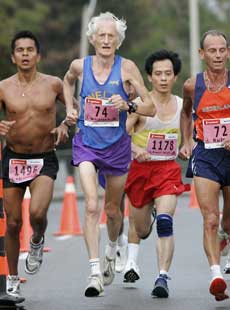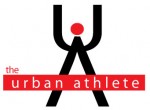 Repost: I originally posted this in October 2011 but lost it in the great porn/spam database hack debacle of January 2012.
Repost: I originally posted this in October 2011 but lost it in the great porn/spam database hack debacle of January 2012.
Purpose: To highlight some key differences in impact loading in older runners versus younger runners
I’ve been meaning to write this post forever and thought I could provide some amazing insight into the study in respect to all of the other great research on running mechanics out there. Well, I can’t. I suck. The study is beautiful enough as it is so I thought I should share it and document the findings for myself as well as any readers.
Sicco Bus (2003) performed a study entitled ” Ground Reaction Forces and Kinematics in
Distance Running in Older-Aged Men”. The author looked at joint kinematics (how joints move) and ground reaction forces (the loads that travel from the feet into the body) in young men and older men (55-65) while running on a track. The groups ran at both a self selected running speed (SRS) and a controlled speed (CRS). For simplicity here is a picture of the main results:
Interesting Points from these results
- -the younger runners ran faster at self selected speeds (duh, but not duh for me because I smoked by older runners on a daily basis - never judge a runner by age, sex or size)
- -even at the same speed older runners had both higher peak impacts (expressed relative to body weight) and higher loading rates
- -older runners had shorter strides and a higher stride rate (1.38 Hz) well short of the “magical” but unfounded 180 steps per minute.
- -older runners tend to have greater knee flexion at the time of foot strike but then they had less flexion (range of motion) while they bent their knee during the load absorption phase of landing and subsequently toeing off.
- -older runners also had smaller amounts of ankle range of motion
Digested Take Home Points
What I find most interesting about this paper is the finding that even when running at the same speed the younger runners had less impact peak and less loading rates. It should also be highlighted that the older runners tried to do the stride modifications typically recommended to lower their impact forces and rates (e.g. increase stride rate and reduce stride length) but still had more impact forces at the same pace as the younger runners. It would be interesting to see how high their kinetic/loading variables would be if they ran with the same stride variables as the younger runners.
What we don’t know is why older runners had more impact forces…and to my knowledge no study has occurred in the past 8 years answering this. What it does strongly suggest is that the method most commonly espoused to influence loading rates and loading impact levels (e.g. changing stride rate and stride length) did not cut it. Nor was it correlated with the kinetics. And lets not forget, the big question is whether it even matters.
Kinematically (aka, how your movements look) the differences in knee joint range of motion is significant. Older runners have less of range of movement but still have higher degrees of force through their joints. This suggests greater stiffness in their knees and ankles.
Final Take Home Points
This is a very neat study and I would encourage you to read the entire thing as the discussion is very detailed. But don’t conclude that older runners are more prone to injury because there is more loading and higher loading rates. . . And for the love of tempo runs don’t stop running. You don’t stop running because you get old, you get old because you stop running. I stole that quote, please inform me of the source.
Related Posts on the Web
1. From Alex Hutchinson’s super blog at Runner’s World Sweat Science:
http://sweatscience.runnersworld.com/2012/04/older-runners-are-less-springy-soft-shoes-are-more-springy/




